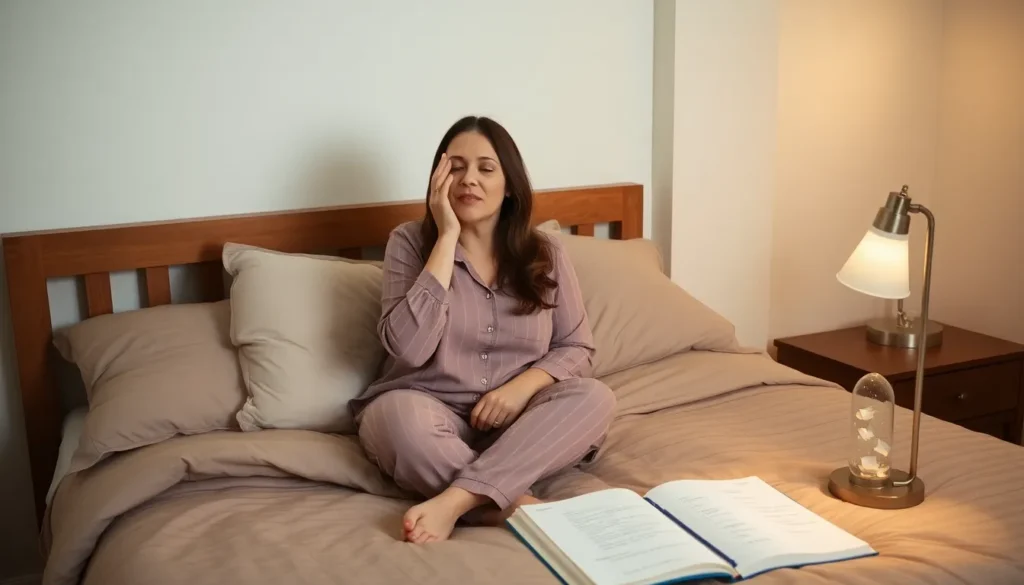Ever found yourself staring at the ceiling at 3 a.m., wondering if your bed is secretly plotting against you? You’re not alone. Sleep cues are those subtle signals that your body sends out, like a sleepy toddler waving a tiny white flag. Recognizing these cues can transform you from an insomniac night owl into a well-rested morning person, ready to tackle the day—or at least the coffee machine.
In a world buzzing with distractions, mastering sleep cues is like finding the holy grail of rest. Whether it’s that dreamy yawn or the sudden urge to cuddle your pillow, these signs can guide anyone toward a peaceful slumber. So, let’s dive into the fascinating world of sleep cues and uncover how they can turn your nightly battles into a cozy rendezvous with dreamland. Who knew bedtime could be this exciting?
Table of Contents
ToggleUnderstanding Sleep Cues
Sleep cues are essential signals that the body presents, indicating a need for rest. Recognizing these cues can substantially enhance sleep quality for individuals seeking better slumber.
Definition of Sleep Cues
Sleep cues refer to physical or behavioral signs that indicate fatigue. Common examples include yawning, eye rubbing, and changes in mood. These signals often arise when someone transitions from wakefulness to sleepiness. People experiencing these signs may find it beneficial to observe them closely. Understanding these manifestations assists individuals in identifying the right moment for sleep.
Importance of Sleep Cues
Recognizing sleep cues plays a crucial role in achieving restorative sleep. Awareness of these signs can help individuals establish a consistent bedtime routine. Improved sleep leads to enhanced focus, mood stability, and overall health. Missing these cues often results in difficulty falling asleep, contributing to insomnia. Prioritizing the acknowledgment of sleep cues fosters a smoother transition to rest, allowing for a more rejuvenating sleep cycle.
Types of Sleep Cues

Sleep cues fall into two main categories: physical and environmental. Recognizing these types aids in promoting better sleep.
Physical Sleep Cues
Physical sleep cues include various signs of fatigue, such as yawning, eye rubbing, and changes in posture. Yawning often signals the body’s readiness for sleep, while eye rubbing indicates growing tiredness. Those who exhibit declining energy levels or changes in heart rate experience typical physical signs. Additional signs include frequent blinking, slower movements, and restlessness. Being aware of these cues promotes timely sleep transitions and enhances overall sleep quality.
Environmental Sleep Cues
Environmental sleep cues encompass external factors influencing sleep readiness. Dim lighting effectively signals the brain that it is time to wind down. Similarly, a cool room temperature creates a comfortable sleep environment. Noise levels play a significant role; tranquil settings promote relaxation and better sleep onset. Likewise, familiar sleep associations like bedtime stories or soothing music cue the body for rest. By manipulating these environmental factors, individuals can nurture a peaceful atmosphere to facilitate falling asleep efficiently.
Recognizing Your Sleep Cues
Identifying sleep cues can significantly enhance sleep quality. Individuals benefit from pinpointing their unique signs of fatigue.
Observing Personal Patterns
Personal patterns reveal individual sleep cues. Many people notice they yawn, rub their eyes, or feel irritable when tired. Tracking these behaviors helps in recognizing what signals the body’s readiness for rest. Changes in energy levels often correspond with specific times of day. Understanding these patterns leads to anticipating sleepiness. A consistent observation routine not only aids in sleep cue recognition but also promotes healthier sleep habits.
Keeping a Sleep Diary
Maintaining a sleep diary fosters awareness of sleep cues. Individuals can document sleep times, wake-up times, and how they feel throughout the day. This data highlights correlations between behaviors and sleep quality. Noting specific cues like yawning or mood shifts enhances awareness of personal signals. Analyzing this information over time reveals patterns and trends that indicate optimal sleep times. This practice encourages proactive adjustments to bedtime routines, enhancing the overall sleep experience.
Implementing Sleep Cues
Recognizing and implementing sleep cues can significantly improve sleep quality. By making simple adjustments to daily routines, individuals can enhance their overall restfulness.
Creating a Sleep Routine
Establishing a consistent sleep routine promotes better sleep patterns. Individuals should aim to go to bed and wake up at the same time each day, reinforcing their body’s natural rhythms. Setting these regular hours encourages the body to anticipate rest. Incorporating calming activities before bedtime, like reading or taking a warm bath, enhances relaxation. Maintaining a technology-free environment an hour before sleep also minimizes distractions. By following these steps, individuals can signal their bodies that it’s time to rest.
Utilizing Relaxation Techniques
Incorporating relaxation techniques serves as an effective strategy for enhancing sleep cues. Deep breathing exercises help relieve tension and induce calmness, making it easier to fall asleep. Practicing mindfulness or meditation also encourages a peaceful mindset, facilitating a smoother transition to sleep. Aromatherapy with calming scents like lavender can further promote relaxation. Engaging in gentle yoga or stretching routines before bed aids in physical relaxation. These techniques, when utilized regularly, create a tranquil atmosphere conducive to restful sleep.
Recognizing sleep cues is essential for anyone seeking to improve their sleep quality. By paying attention to physical and environmental signs of fatigue, individuals can create a more conducive atmosphere for rest. This awareness not only enhances the overall sleep experience but also promotes better health and well-being.
Implementing a consistent sleep routine and incorporating calming pre-sleep activities can significantly transform bedtime into a more enjoyable experience. With a proactive approach to understanding personal sleep patterns, anyone can turn the journey to restful sleep into a rewarding and rejuvenating process. Prioritizing these cues paves the way for a peaceful night’s sleep and a brighter day ahead.






